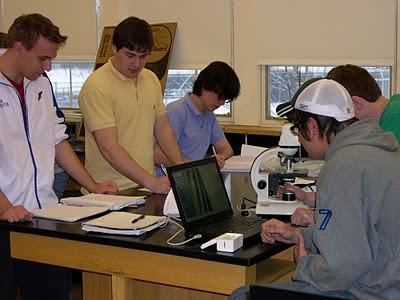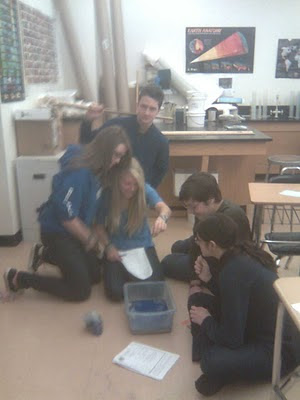Manhattan College Engineering Summer Institute Application
This summer the Mechanical Engineering Department at Manhattan College is sponsoring its 14th Annual Summer Institute for high school students. It consists of an intensive, four-day program intended for high school sophomores and juniors interested in exploring the field of engineering. The session will be held July 25-28.
Follow the link above for the original letter and an application which must be submitted with a letter of recommendation from your guidance counselor or a math/science teacher by April 29, 2011.
Manhattan College Engineering Summer Institute
Science News and Happenings of Interest to the Bronxville School Community
Tuesday, March 29, 2011
Monday, March 21, 2011
Boiling Water Nuclear Reactor
The following video examines how the reactors like the ones damaged by the tsunami and earthquake in Japan function.
Forensic Students Study Hair and Fiber Standards
In the Forensic Science class, the students are currently studying examples of trace evidence, in this case hairs and fibers. To do this the students are using our digital microscopes to exam "standards" known samples of different types of hairs and fabrics. They will then use these knowns as a basis of comparison to identify an unknown sample of trace evidence by indicating its source.
In this unit the students learned the characteristics used to distinguish the hairs from different animals, humans, and the three races of humans. Structural differences between these hairs allow their identification. The students learned to identfy different cuticle patterns and medullary patterns which are used to classify hair from different animals and humans.
The hair samples used were from cats, dogs, rats, human dyed hair, human blonde hair, human natural gray hair, human brown hair, and human red hair. In addition to these samples, prepared slides contained sheep, wooly mammoth, mouse, deer, rabbit, mink, musk rat, seal and horse hairs.
In this unit the students learned the characteristics used to distinguish the hairs from different animals, humans, and the three races of humans. Structural differences between these hairs allow their identification. The students learned to identfy different cuticle patterns and medullary patterns which are used to classify hair from different animals and humans.
The hair samples used were from cats, dogs, rats, human dyed hair, human blonde hair, human natural gray hair, human brown hair, and human red hair. In addition to these samples, prepared slides contained sheep, wooly mammoth, mouse, deer, rabbit, mink, musk rat, seal and horse hairs.
 |
| K. Abiko and A. King are measuring the diameters of the hairs they have already captured digitally. |
 |
| N. Janney and M. Warnken have catalogued all their various hairs. |
 |
| I. Markota, K. Bisconti, J. O'Neill, K.Stack and J. Burns compare notes and images collected. |
Thursday, March 17, 2011
Honors Core Chemistry Class Probe Phase Change/Energy Relationship
In Ms. Meyer's Honors Core Chemistry class, the ninth graders use temperature probes, graphing calculators and laptops to determine the change in temperture that occurs in a phase change (solid to liquid/liquid to solid). Graphing this data, they should be able to visualize the relationships that exist between temperature, heat and energy by observing the trend/pattern shown in the graph. They can then calculate the actual amount of energy absorbed (during melting) and released (during freezing). This initial investigation introduces the students to thermochemistry. Further investigations will involve determining the specific heat of a metal and determining the Calorie content in a cheese doodle!!!
Wednesday, March 16, 2011
Sixth Grade Moon Phase Model Project
Mr. Viggiani's sixth grade classes were given a group project to creatively build a model to represent the phases of the moon.
 |
| The "Ace of Cakes" better beware, this group of Bronxville Sixth Graders are prepared to give you some tough competition! |
 |
| Had Harold Arlen seen this representation of the phases of the moon, would he and his collaborators had written "Its Only an Oreo Moon" instead of "Its Only a Paper Moon"?? |
 |
| This model that looks good enough to eat! |
 |
| This creative model of moon phases resurrected the Hula Hoop. Will the Pet Rock be next? |
Tuesday, March 15, 2011
Grade 8 Science Classes "Sludge" Test
The curriculum in the Eighth Grade of Bronxville Middle School is primarily one that studies the nature of matter, Chemistry. In the pursuit of this study the students discuss and observe the various physical properties of matter. They observe, develop protocols, and carry out inquiries into these physical properties. They then learn different techniques that are based on these properties and can be used to separate different phases/forms of matter from a mixture. One major performance assessment is the sludge test, in which the students are given a sample of sludge and asked to use what they have learned to separate it into its component substances.
 |
| Google....sludge.......Sludge refers to the residual, semi-solid material left from industrial wastewater, or sewage treatment processes. It can also refer to the settled suspension obtained from conventional drinking water treatment,[1] and numerous other industrial processes. The term is also sometimes used as a generic term for solids separated from suspension in a liquid; this 'soupy' material usually contains significant quantities of 'interstitial' water (between the solid particles). |
 |
| (Apologies to the Monotones) "I wonder, wonder, what's in my tube of sludge!" |
 |
| Let's see if we can find it in here........muck.....mud.....ooze......ah...here it is SLUDGE! |
Science Olympiad Team Places Fifth at Olympiad Regional
Coach Windels and Mr. Viggiani accompanied the Middle School Science Olympiad team to Scarsdale Middle School where the team competed at the regionals on Saturday, March 12th and placed 5th out of 27 teams. This qualified the team for the state competition which will be held at Ulster Community College on April 8th and 9th. The team consists of 19 students in grades 6 - 9.
Monday, March 14, 2011
Norfolk Botanical Gardens Eagle Nest Cam
Follow this link Eagle Cam
It leads to a public TV web page in Virgina. The page contains a 24 hour streaming web camera trained on a bald eagle nest. It also contains a blog area on the right side of the page, in which there is an ongoing discussion about the eagles and their nesting habits. Also the bottom of the page contains slide show compiled of parts of the camera's streams from previous days/weeks. A very interesting site!
It leads to a public TV web page in Virgina. The page contains a 24 hour streaming web camera trained on a bald eagle nest. It also contains a blog area on the right side of the page, in which there is an ongoing discussion about the eagles and their nesting habits. Also the bottom of the page contains slide show compiled of parts of the camera's streams from previous days/weeks. A very interesting site!
Friday, March 4, 2011
AP Environmental Science Wind Turbine Lab
 |
| Picture of Canadian Wind Farm from www.dropyourenergybill.com |
The AP Environmental Science course covers a variety of topics, including the examination of alternative energy sources. One of these is the conversion of the wind's kinetic energy into mechanical energy which can generate usable power to do work.
Traditionally this energy would be captured by the blades of a windmill. The wind passing over the blades causes them to rotate. The mechanical energy of this rotation was then harnessed to drive mill stones for grinding grains or mechanical pumps to draw water from wells or drive irrigation systems. In their more modern iterations, these simple machines' rotational mechanical energy is used to generate electrical energy. Such machines are the modern wind turbines that are currently being deployed in wind farms to generate electrical energy.
Blade material, shape, and size have a major effect on the power a wind turbine can generate. Other variables in blade design, such as blade length, pitch, and weight can be manipulated to maximize efficiency. In this exercise the students manipulate these variables and try to design a blade that will generate the most electrical energy as measured by current produced in their simple circuits.
 |
| Aine, Michaela, Kathleen etal. decided to go with a three bladed turbine, whose blades were relatively long, broad and tear shaped. Their pitch looks moderate. |
 |
| Gibbs, Kevin, Brendan etal. went with a turbine with five relatively short blades with what look like a rather severe pitch. |
 |
| The blades on Greg, Billy, Matt and Jack's turbine seemed more "squared" off and of moderate length. From this angle the blades appear to have almost no pitch. |
 |
| Nina, Jan and Niki chose to design their turbine with three large "bullet" shaped blades with minimal pitch. |
 |
| Sam, Nick, Angus etal. designed a six bladed turbine with the "tapered square" shape. The pitch of the blade appears to be minimal. |
Tuesday, March 1, 2011
AP Biology Students' Organ System Presentations
The Third Quarter Project I
Must be a well-made PowerPoint, Summary Handout and Class Presentation of the Organ System you volunteered to present to the class! You have been chosen a group to work with and your group has elected to examine a particular human organ system. It is the job of your group to present the relevant information about that system to the class on the date that posted on the Ed-line Calendar. You will have time in class to work on your presentation and it is expected that you work outside of class on it as well. In addition to the presentation, you will compile a summary sheet of information for the class about your system.
Animal Organ Systems
Evolution of the Organ System
Include a description of how the organ system evolved in relation to the phylogeny of the animal kingdom. Your presentation should summarize the organs and functions of the systems in the major animal phyla. The usual phyla and representative organisms are as follows: Cnidaria-jellyfish, Platyhelminthes-Planaria, Nematoda-Ascaris, Annelida-Earthworm, Arthropoda-Grasshopper
Human Organ System and Function
What are the major organs? What is the system’s function? How is the system involved in the maintenance of homeostasis? What is the functional unit of the system and how does it work within the system?
Functional Unit/Functioning of the System
List the organs and their roles. Include pictures to indicate how the structure is related to the function of the organ. Explain functional unit and how it works. Describe how this system interacts with the other systems in the body?
Malfunctions of the Organ System
Identify and describe any of the major malfunctions that alter the normal function of the organ system.
E-mail Presentation
You must E-mail me a copy of your presentation and summary handout well before its due date so that I can run off copies of a handout of your presentation for your classmates to take notes during your presentation.
B. Davies, L. Florek, S. Monaco - Sensory and Motor Systems
Davies Florek Monaco Sensory and Motor Mechanisms Project
Grealy Sensory_and_Motor_system FINAL
Rwf Apbio Nervous System Project
Pennoyer APBIOLOGYNERVOUSSYSTEMfinal[2]
Carpenter Animal Reproduction Carpenter Animal Reproduction
Cody Bothwell Detwiler Reproductive system E
Grunseich Osmoregulation and Excretion
Mattes Etal Osmoregulation
Sargent Immune System
Braumuller Circ Resp
B. Davies, L. Florek, S. Monaco - Sensory and Motor Systems
Davies Florek Monaco Sensory and Motor Mechanisms Project
C. Grealy - Sensory and Motor Systems
Grealy Sensory_and_Motor_system FINAL
Colvin, Faselt, Torres - Nervous System
Rwf Apbio Nervous System Project
Pennoyer - Nervous System
Amboss, Gray - Endocrine System
Gray Amboss Endocrine Presentation Carpenter - Animal Reproduction
Carpenter Animal Reproduction Carpenter Animal Reproduction
Bothwell, Cody, Detwiler - Animal Reproduction
Cody Bothwell Detwiler Reproductive system E
R. Grunseich - Osmoregularity
Grunseich Osmoregulation and Excretion
K. Bianco, K. Bopp, B. Mattes - Osmoregularity (Excretory System)
Mattes Etal Osmoregulation
G. Sargent - Immune System
Sargent Immune System
K. Noonan, S. Blessing, C. Louka - Immune System
Subscribe to:
Posts (Atom)

























